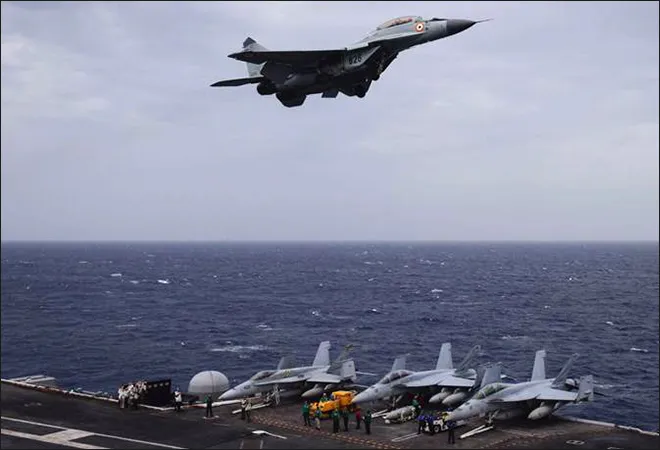
While there is yet to be a consensus on what constitutes the “Indo-Pacific”, it is widely viewed as the region that covers the Asia-Pacific and India. The Indo-Pacific comprises of both Indian and the Pacific Oceans, and is essentially more of an ideological construct for a regional strategic framework.
In 2007, the formation of what would be called ‘Quad’—the informal aggrupation of Japan, India, the United States and Australia—was centred on their shared values of democracy and rule of law, and a mutual commitment to ensure the stability of their maritime commons in the Indo-Pacific. The Quad works towards maintaining the balance of power in the Asia-Pacific. The Obama administration at that time used the term “Asia-Pacific”; when US President Donald Trump took his position, the Quad began using the term “Indo-Pacific” to encapsulate the idea of greater Indian influence and isolate China at the same time. The idea of Indo-Pacific is also being firmly supported by the European Union. However, there is skepticism whether the region will succeed and be systematically institutionalised in the future, as several countries in the region are not actively involved in it, including South Korea and the Philippines.
The concept of a “free and open Indo-Pacific” is widely espoused across the world; it means that countries can act without any coercion and engage in trade and investment in simpler ways. Japan was the first country to use the concept. Prime Minister Shinzo Abe has stressed that Japan is consistently working towards this vision that focuses on the creation and development of new connectivity corridors. Indian Prime Minister Narendra Modi also adopted the same concept. The primary focus of Indo-Pacific is centred on oceans, and India occupies an important strategic position in the Indian Ocean. Maritime connectivity between India and its trade partners is imperative for Indo-Pacific connectivity. PM Abe’s Indo-Pacific strategy is a counterbalance with regard to the expansion of the Chinese influence in Eurasia and Africa under President Xi Jinping’s massive Belt and Road Initiative (BRI). Intertwined with the BRI, China has already consolidated its presence in the ports of Djibouti in the Horn of Africa, Gwadar in Pakistan, Hambantota in Sri Lanka, as well as in the Maldives and in Tanzania. Japan has seen the rise of China for long. What Japan would have never imagined is that China would end up creating an excessive supply and capacity. The BRI began as a case of managing excess capacity for China. However, it has transformed from an economic project, to a soft power initiative, and now to a hard power proposition because of responses and alternative propositions.
The Indo-Pacific idea as used by Trump means that India, the United States, Australia, and Japan will join in curbing China in the new framework of growing Cold War influence. Many Chinese scholars believe that the Indo-Pacific strategy is intended to hedge against China’s foreign and security policy. Furthermore, China’s BRI gave an impetus to the economic linkages across the Indo-Pacific region, of which the US still has no accurate geopolitical response. The fundamental aim of the Indo-Pacific strategy of the US is to prevent the rise of China and lessen its influence in order to ensure and stabilise the supremacy of the US in the Indo-Pacific region through political, diplomatic and military support. Washington’s efforts aim to counterbalance Beijing’s ever-expanding military advancements and investments in the region. During the Raisina panel discussion, Daniel Kliman observed that China is yet to articulate a clear vision on the concept of Indo-Pacific and its future is contested.
Indeed, China is the proverbial elephant in the room. Since China has more economic presence, it is believed that Indo-Pacific is a reflection of rise of both China and India. It is also a reflection of interactions and connectivity between Asia-Pacific and Indian Ocean. From a political perspective, the reflection of emerging great-power competition comes into force. The challenge for the future order in this region is the decrease of great-power competition. It is in China’s interest to keep the region open, stable and prosperous. To maintain the Indo-Pacific order, there shall be more accommodation and communication between major powers who should observe the centrality of the ASEAN in regional cooperation and its mechanisms need to play a major role. Regional economic cooperation and integration should be promoted and common challenges like terrorism, climate change, poverty and other regional and global crises ought to be addressed carefully. Differences and disputes should be managed well through peaceful settlement. Major emphasis must be given on the promise of a ‘free, open and also sustainable Indo-Pacific’ for developing social, environmental and governmental standards of investment and development. In addition, the US, Japan, India, and Australia must improve coordinating and joint adoption of policies and strategies.
This essay originally appeared in Raisina Dialogue Conference Report 2019
The views expressed above belong to the author(s). ORF research and analyses now available on Telegram! Click here to access our curated content — blogs, longforms and interviews.




 PREV
PREV

